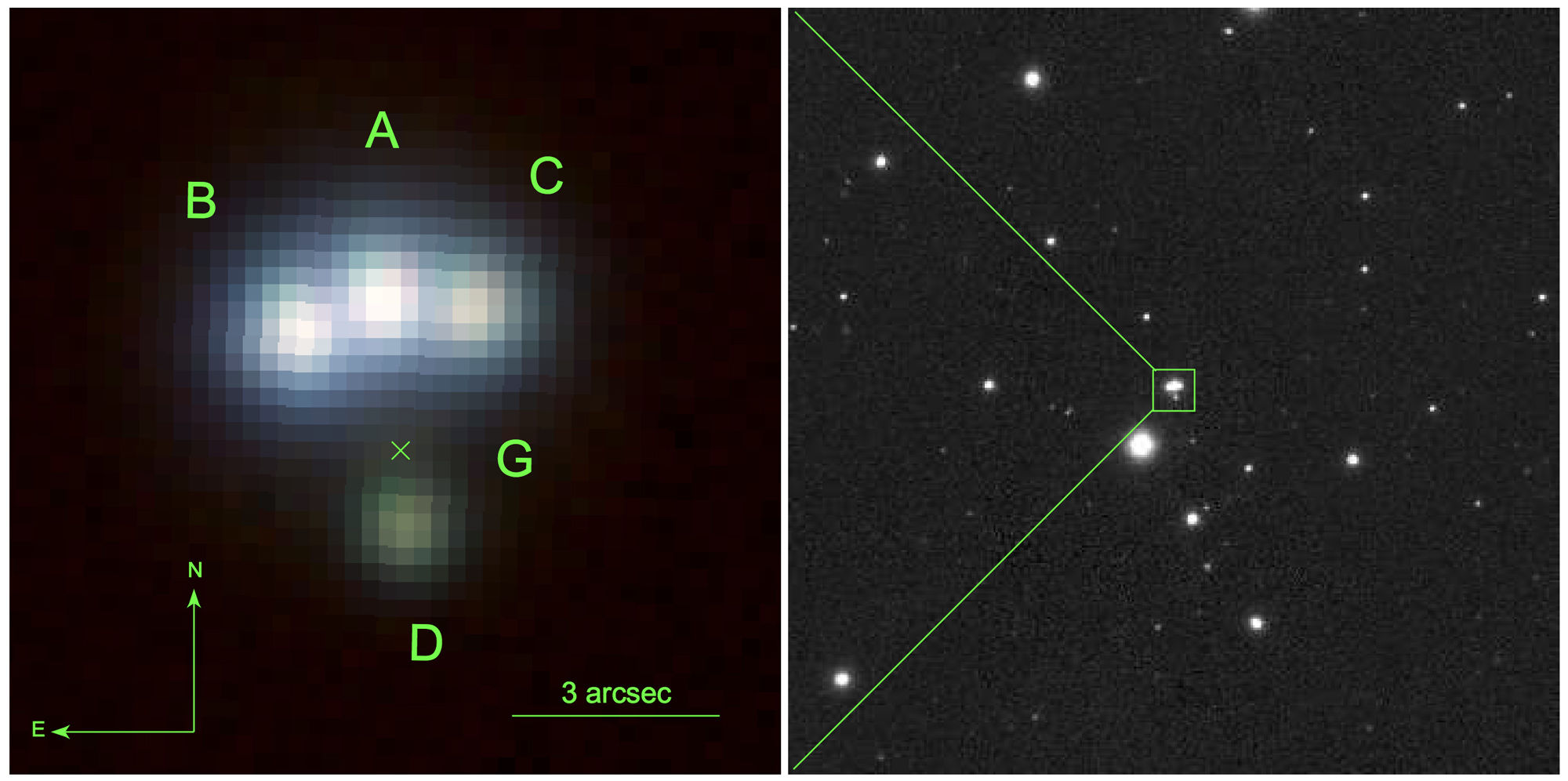Create a free profile to get unlimited access to exclusive videos, sweepstakes, and more!
The chained princess’s drogue

This is pretty cool: Astronomers found a quadruply gravitationally lensed quasar by accident!
Quasars are actually galaxies much like our own Milky Way. Every big galaxy has a supermassive black hole in its core, and as material falls into that black hole it can pile up on the outside and form a disk. Friction in the disk heats it to ridiculous temperatures, and it glows intensely. Sometimes this disk can outshine all the stars in the entire galaxy! Generically we call these systems “active galaxies” (or active galactic nuclei, since all the action is in the center). There are many different kinds, depending on their characteristics.
Quasars (so-named because they are quasi-stellar radio sources: They look like stars, but blast out radio waves) are usually pretty far away — the first ever found, 3C 273, is a billion light-years from us! Most are much farther than that.
We can learn a lot about them by studying their brightness. Sometimes clumps of matter fall in, and the brightness can fluctuate. Recently, a grad student at the U.S. Naval Observatory named George Nelson was looking at variable quasar data, and he spotted something odd. He was looking at observations using Pan-STARRS (the Panoramic Survey Telescope and Rapid Response System, a 1.8 meter telescope on Haleakala in Maui, which observes huge chunks of the sky at a time), and it turned out what he found was a quasar that was distorted by a strong gravitational lens.
OK, so what’s a gravitational lens? This is when a third object like a galaxy is between us and a more distant object. The gravity of the intermediate object bends the light coming from the background object, causing all sorts of weird effects. The image can be smeared out in an arc or circle, its light can be magnified (made brighter), or multiple images can appear around the center. Because the light gets bent we call this effect lensing, where the galaxy doing the bending is the lens and the more distant object we call the lensed object.
In this case, the quasar, called J014709+463037 (after its coordinates on the sky) is a staggering 11 billion light-years away — nearly 80% of the way across the visible Universe! The lens is a galaxy “only” half that distance, about 5.6 billion light-years away. The geometry of the lensing makes multiple images of the quasar around the lensing galaxy: Three above it, and one fainter one below. That makes this a relatively rare quadruple lensed quasar.
Follow-up observations were made using the ginormous Keck telescope (also in Hawaii, on the Big Island) and confirmed the ID as a quasar, and refined the distances to both the lens and the lensee.
One reason these types of objects are interesting is that, by definition, each image of the quasar that we see took a different path to reach us, and some paths are longer than others. So if, say, the quasar’s black hole swallowed some big gas cloud and flared up, we’d see that happen in the four images at different times! The delay can be days, weeks, or even months, depending on the geometry. This allows multiple observations of one event, sorta like time travel. It also can reveal more information about not just the quasar but also the lensing galaxy. Because it’s the gravity of the galaxy that does the bending, and that depends on the mass, the lens can help us map out the distribution of material in that intervening galaxy. So we get info about both distant objects this way!
Only about 40 such quadruple lensed quasars are known, and this is the first seen in Pan-STARRS data. Given how Pan-STARRS takes wide, deep images, I imagine a lot more will be found. [Addendum: In between the time I wrote this article and the time it was published, another quad lens was found! So I guess I was right.]
And despite all this, I have to tell you the part that makes me smile. The shape of the lensed image, together with its location on the sky, have led to it being given a fun nickname: Andromeda’s Parachute.
I totally see it.
[P.S. If you’re wondering about this article’s title: Andromeda was the daughter of Cepheus and Cassiopeia, king and queen of Aethiopia in Greek mythology. As usual in such stories, boasting about her beauty led to jealousy: She’s chained to a rock on a beach, and Poseidon sends the sea monster Cetus to kill her, but the serpent is instead killed by Perseus using the severed head of Medusa. Just another Saturday in mythology. But, bringing this back to astronomy: Every single one of those characters is represented by stars and constellations in the sky, even Medusa’s head (the star Algol). My early love for mythology was fueled in part by its connection to astronomy.]



























